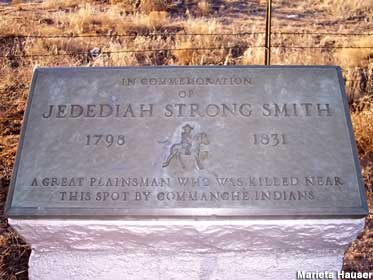1828: Jedediah Smith, Harrison Rogers, and SW Oregon as a suburb of Ft Vancouver
Jedediah Strong Smith (1799-1831) and pals were the first US folks to reach the Oregon Country from California.
Lionized decades after death as a mountain man, Smith was in fact a literate New Yorker, thought to be inspired by a copy of Lewis & Clark’s journals.
His contributions to society mostly came from his trailblazing explorations of the far West.

Because I found no pictures of Rogers (image credit: Roadside America)
For us, the main attraction is actually his often-overshadowed second-in-command Harrison G. Rogers’ diary of those activities.
It’s not as if Jedediah Smith and company spent much of their careers in the Pacific Northwest, or as a rule necessarily learned Chinook Jargon.
But Rogers may have spoken, or at least recognized CJ — plus, well-known Jargon-speaking interpreter Michel La Framboise was along with the group. And about half of the crew were French Candians and/or métis, with surnames such as Lazarus, Laplant, and Marishall, who we can guess knew Jargon due to associations with Fort Vancouver.
And there’s one stretch of several days in southwestern Oregon in Rogers’ diaries that is of definite value for us as students of CJ history.
Here are some remarkably early Chinuk Wawa communications in that region:
On the Coquelle / Coquille River, presumably with the Milluk people:
Saturday, July 5th, 1828. We travelled 1 ½ miles to-day N. and, finding good grass, enc[amped]. as our horses was pretty tired. Two Ind[ian]s., who speak Chinook, came to our camp; they tell us we are ten days travell from Catapos on the wel Hamett, which is pleasing news to us.
— quoted at Coquelle Trails
Then with the Quuiich (Coos) people:
Friday July 11th 1828. All hands up early, and under way had an Ind. who speaks Chinook, a long as a guide. Our course was N along the Beach of the Ocean, 15 miles and struck a River that is about 300 yards wide at the mouth and enc, as it was not fordable, we Crossed a small creek, 30 yards wide, 10 miles from camp — to-day — we enc. where there was some Inds. liveing — a number of them speak Chinook — 70 or 80 in Camp, they bring us fish & Berries and appear friendly, we buy those articles from them at a pretty dear rate — those Inds call themselves the Omp quch.
— as published in Dale Morgan’s book “Jedediah Smith” (Indianapolis, IN: Bobbs-Merrill, 1953), page 266
And then getting information from Upper Umpqua Athabaskans (I’m guessing) at the confluence of the Umpqua and Smith Rivers, about K’alapuyan and Chinookan country:
Sunday July 13th 1828. …50 or 60 Inds. in camp again to-day (we traded 15 or 20 Beaver skins from them — some Elk meat & tallow, also some lamprey eels) … Those Inds. tell us after we get up this River 15 or 20 miles we will have good travelling to the Wel Hammett or Multenomah — where the Callipoo Inds live —
— pages 266-267 of the same book
Among the above-mentioned groups, we’re told there was a significant presence of Euro-American trade goods. And these people were noted as not overly shy about approaching Smith’s group, unlike some tribes nearby.
This, plus the fact that several among them spoke Chinuk Wawa (also unlike more southerly tribes), indicates that these SW Oregon folks were already part of the Fort Vancouver world.
This is quite a remarkable observation, in that we hardly find CW at any distance from the last 80 or so miles of the Columbia River in the early days of Fort Vancouver (established 1825)!
The Hudsons Bay Company’s Fort Umpqua wasn’t even founded until 1832.
It seems somewhat doubtful to me that SW Oregon Native people had yet personally visited Fort Astoria/Fort George (est. 1811), or Fort Vancouver. I may be proved wrong about this detail.
I’m inferring that they did, however, have ongoing contacts with Yoncalla K’alapuyans, whose territory included part of the upper Umpqua. The various K’alapuya tribes, who spanned the Willamette River drainage from here almost to the Columbia, did indeed have early-established and sustained relations with the lower Columbia fur traders.
And perhaps more to the point for us, there had already been some exploration and trapping by Euro-Americans southward along the Willamette Valley. The Pacific Fur Company and the North West Company both had posts in the region from the early 1810’s, and would have sent crews out in search of furs. The practice was continued by the HBC when it took over the NWC in 1821.
(In a separate indication of cross-cultural contact this early, botanist David Douglas is said to have encountered the Upper Umpquas in 1826.)
I have doubts that contacts with K’alapuya people were as potent a motivator for SW Oregon natives to learn Chinuk Wawa as the newer presence of the fur traders, bringing highly valued merchandise, was.
So it looks as if Milluk, Quuiich, and Upper Umpqua country was already a “suburb” of the Fort Vancouver world by 1828, a time period when Chinook Jargon was still otherwise confined to the zone of forts and métis settlements along the Willamette-Cowlitz-Nisqually (and Fort Langley) corridor.
